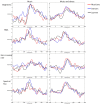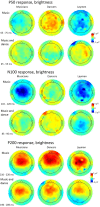Early auditory processing in musicians and dancers during a contemporary dance piece
- PMID: 27611929
- PMCID: PMC5017142
- DOI: 10.1038/srep33056
Early auditory processing in musicians and dancers during a contemporary dance piece
Abstract
The neural responses to simple tones and short sound sequences have been studied extensively. However, in reality the sounds surrounding us are spectrally and temporally complex, dynamic and overlapping. Thus, research using natural sounds is crucial in understanding the operation of the brain in its natural environment. Music is an excellent example of natural stimulation which, in addition to sensory responses, elicits vast cognitive and emotional processes in the brain. Here we show that the preattentive P50 response evoked by rapid increases in timbral brightness during continuous music is enhanced in dancers when compared to musicians and laymen. In dance, fast changes in brightness are often emphasized with a significant change in movement. In addition, the auditory N100 and P200 responses are suppressed and sped up in dancers, musicians and laymen when music is accompanied with a dance choreography. These results were obtained with a novel event-related potential (ERP) method for natural music. They suggest that we can begin studying the brain with long pieces of natural music using the ERP method of electroencephalography (EEG) as has already been done with functional magnetic resonance (fMRI), these two brain imaging methods complementing each other.
Figures



Similar articles
-
Dance on cortex: enhanced theta synchrony in experts when watching a dance piece.Eur J Neurosci. 2018 Mar;47(5):433-445. doi: 10.1111/ejn.13838. Epub 2018 Feb 16. Eur J Neurosci. 2018. PMID: 29359365
-
Naturalistic music and dance: Cortical phase synchrony in musicians and dancers.PLoS One. 2018 Apr 19;13(4):e0196065. doi: 10.1371/journal.pone.0196065. eCollection 2018. PLoS One. 2018. PMID: 29672597 Free PMC article.
-
Event-related brain responses while listening to entire pieces of music.Neuroscience. 2016 Jan 15;312:58-73. doi: 10.1016/j.neuroscience.2015.10.061. Epub 2015 Nov 7. Neuroscience. 2016. PMID: 26550950
-
Arts, Brain and Cognition.Psychiatr Danub. 2016 Dec;28(4):343-348. Psychiatr Danub. 2016. PMID: 27855424 Review.
-
Dancers' and musicians' injuries.Clin Rheumatol. 2013 Apr;32(4):425-34. doi: 10.1007/s10067-013-2184-8. Epub 2013 Apr 10. Clin Rheumatol. 2013. PMID: 23572035 Review.
Cited by
-
Evaluation of Contralateral Suppression of Otoacoustic Emissions in Bharatanatyam Dancers and Non-Dancers.J Int Adv Otol. 2019 Apr;15(1):118-120. doi: 10.5152/iao.2018.5645. J Int Adv Otol. 2019. PMID: 30541728 Free PMC article.
-
Registered Report: Replication and Extension of.bioRxiv [Preprint]. 2025 Mar 17:2025.03.13.643168. doi: 10.1101/2025.03.13.643168. bioRxiv. 2025. PMID: 40166247 Free PMC article. Preprint.
-
Exploring Frequency-Dependent Brain Networks from Ongoing EEG Using Spatial ICA During Music Listening.Brain Topogr. 2020 May;33(3):289-302. doi: 10.1007/s10548-020-00758-5. Epub 2020 Mar 2. Brain Topogr. 2020. PMID: 32124110 Free PMC article.
-
Coupling of Action-Perception Brain Networks during Musical Pulse Processing: Evidence from Region-of-Interest-Based Independent Component Analysis.Front Hum Neurosci. 2017 May 9;11:230. doi: 10.3389/fnhum.2017.00230. eCollection 2017. Front Hum Neurosci. 2017. PMID: 28536514 Free PMC article.
-
A Systematic Review for Human EEG Brain Signals Based Emotion Classification, Feature Extraction, Brain Condition, Group Comparison.J Med Syst. 2018 Jul 24;42(9):162. doi: 10.1007/s10916-018-1020-8. J Med Syst. 2018. PMID: 30043178
References
-
- Sutton S., Braren M., Zubin J. & John E. R. Evoked-potential correlates of stimulus uncertainty. Science 150, 1187–1188 (1965). - PubMed
-
- Brattico E., Tervaniemi M., Näätänen R. & Peretz I. Musical scale properties are automatically processed in the human auditory cortex. Brain Res. 1117(1), 162–174 (2006). - PubMed
-
- Fujioka T., Trainor L. J., Ross B., Kakigi R. & Pantev C. Automatic encoding of polyphonic melodies in musicians and onmusicians. J. Cogn. Neurosci. 17(10), 1578–1592 (2005). - PubMed
Publication types
MeSH terms
LinkOut - more resources
Full Text Sources
Other Literature Sources
Medical
Research Materials
Miscellaneous

